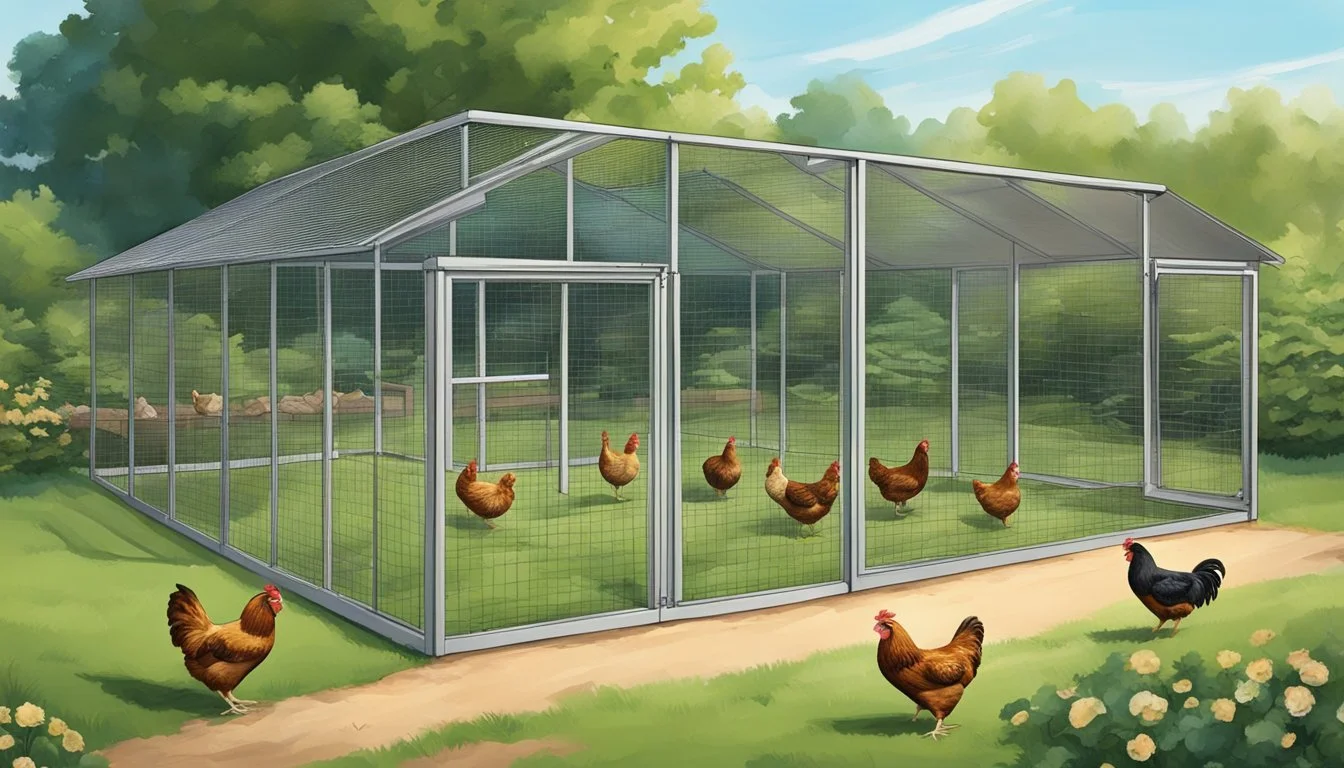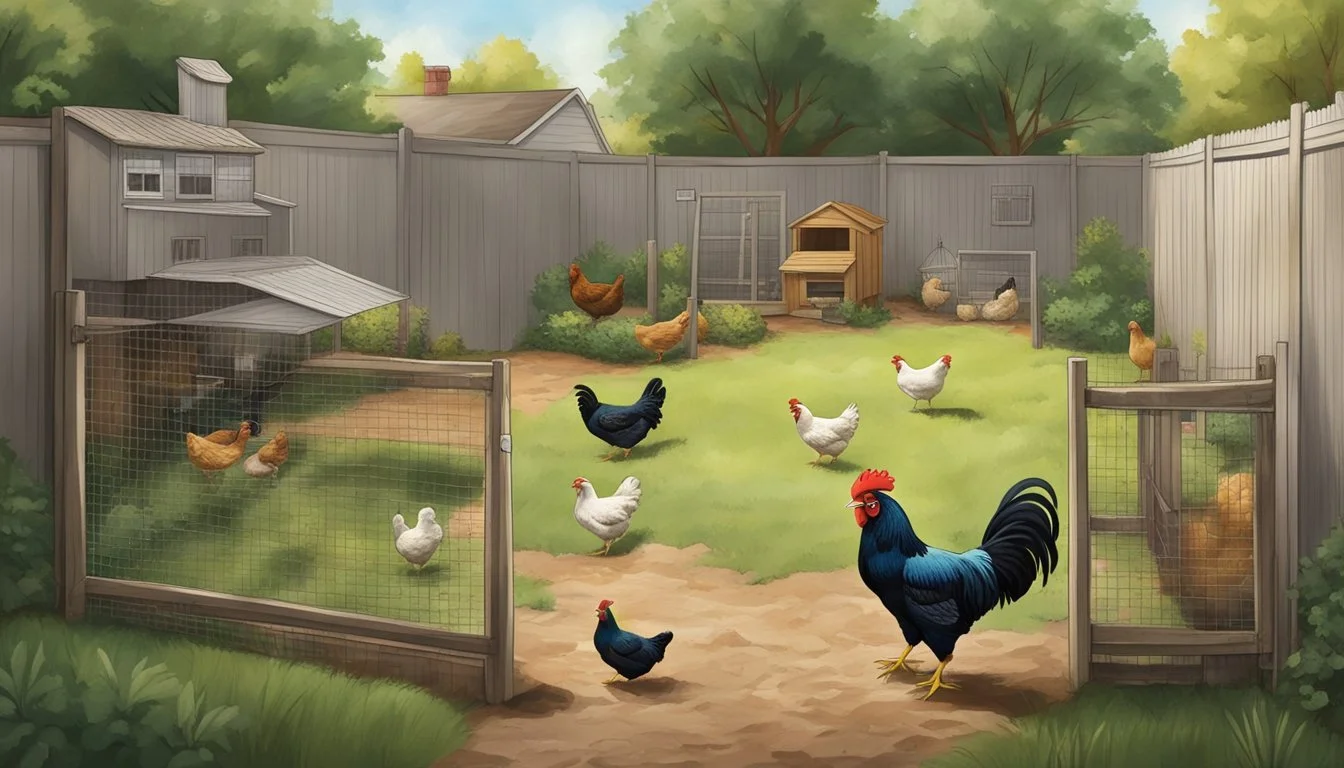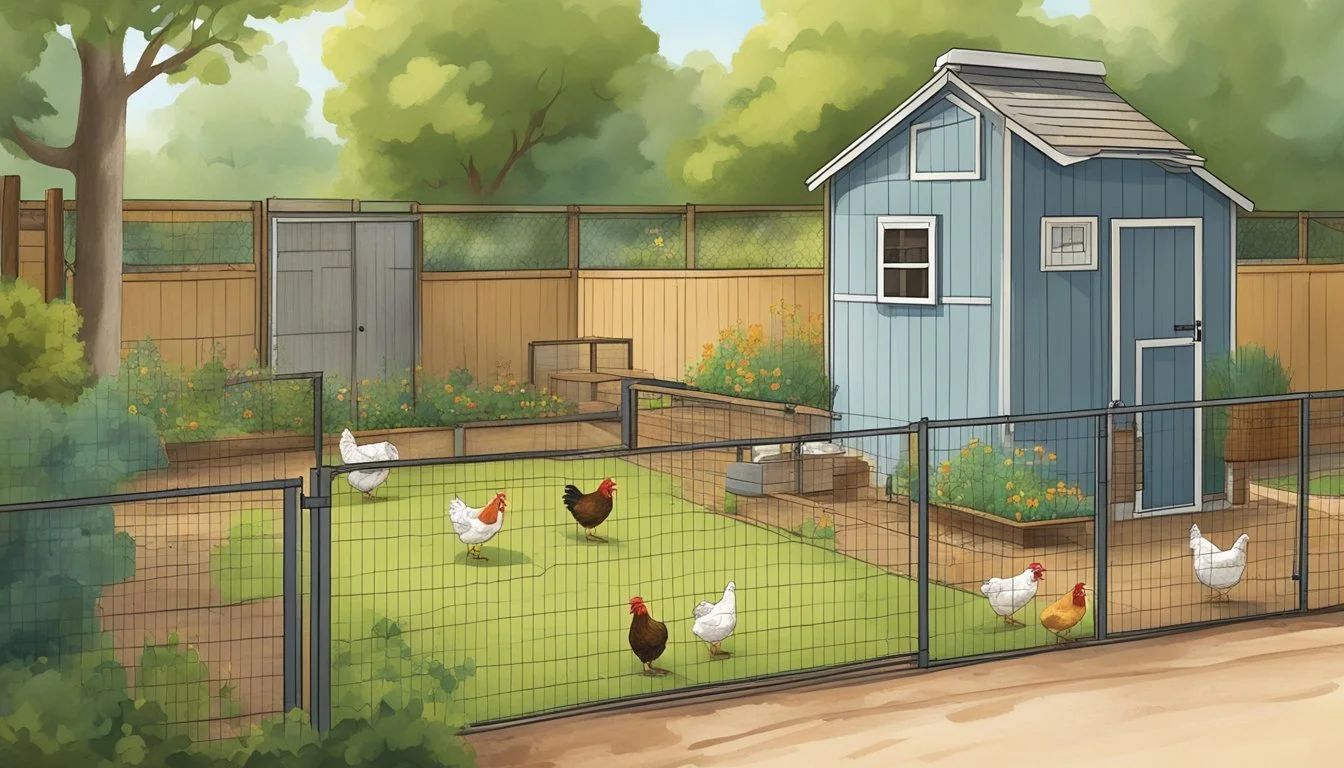Keeping Backyard Chickens in Oklahoma City, OK
Essential Tips for Urban Poultry Farming
Oklahoma City has established clear guidelines that allow residents to engage in the practice of raising backyard chickens. Recognizing the growing trend of urban agriculture and the desire for sustainable living, city officials have enacted ordinances to enable city dwellers to keep chickens in their backyards. Under these regulations, which took effect on March 4, 2022, keeping up to a total of six chickens or quail (What wine goes well with quail?) is permitted, although roosters are not allowed to prevent noise issues.
Residents must ensure that they are in compliance with local zoning regulations, which may impact the legal means by which they can house poultry. This involves maintaining a tidy and predator-proof coop to assure the safety and cleanliness of their environment. While permits are required for chicken keeping in Oklahoma City, these stipulations facilitate a responsible approach to urban farming, accommodating animal welfare and neighborhood standards.
Understanding Local Ordinances
For residents of Oklahoma City considering raising backyard chickens, understanding the specific local ordinances is crucial. These regulations ensure the welfare of the animals, the considerations of neighbors, and the overall community health.
Oklahoma City Chicken Ordinance Overview
In Oklahoma City, the specific ordinances outline that chickens are to be kept within certain zoning laws and be observed by specific rules to maintain a safe and healthy environment. The city permits the keeping of chickens for personal use, though regulations regarding the number of animals and coop placement are in place.
Permit Requirements and Fees
Permitting is a vital step for prospective chicken owners in Oklahoma City. Before setting up a coop, residents must obtain a permit from the Oklahoma City-County Health Department. While the detailed fee structure is not outlined here, checking with the health department will provide up-to-date information on the cost.
Property Line and Space Regulations
Urban chicken keepers must comply with property line and space regulations. Coops and runs need to be situated at least five feet away from the side property line and ten feet away from the back property line. Additionally, they must respect a 30-foot distance from any residential structure on adjacent property. Each chicken should have at least eight square feet of roaming space.
Roosters and Hen-Specific Rules
The city's ordinances provide explicit rules regarding the keeping of roosters and hens. Roosters are often prohibited in urban settings due to noise, although precise regulations in Oklahoma City should be confirmed with the city's ordinance. Hen-specific rules are designed to ensure the well-being of the animals and include stipulations on the number of hens allowed per household within city limits.
Setting Up Your Chicken Coop
When establishing a backyard chicken coop in Oklahoma City, one must comply with specific location requirements, construct a coop of adequate size and design, and integrate safety features to thwart predators.
Choosing the Right Location
It is mandatory for chicken coops to be sited at a minimum distance of five feet from side property lines, ten feet from the back property line, and thirty feet from any neighboring dwelling. One should select a spot that provides shade to protect chickens from excessive heat, and also has enough sunlight to maintain a dry and clean coop environment.
Coop Design and Size Recommendations
A well-designed coop must offer a minimum of four square feet of space per chicken within, ensuring they have enough room to roost and move comfortably. Alongside the coop, at least eight square feet of roaming space per bird is necessary, which can be part of a fenced area or runs attached to the coop. Materials for the coop should be chosen based on their durability and ease of cleaning.
Safety Features to Protect from Predators
Ensuring a clean coop is essential, but so is securing it against predators. Use hardware cloth instead of chicken wire for enclosures to block smaller predators. The coop should have a solid, predator-proof foundation. One should also consider installing locks on doors and ensuring that the coop is completely secure at dusk until dawn when predators are most active. A fenced area or runs can provide additional security while allowing chickens to roam throughout the day.
Chicken Raising Best Practices
In Oklahoma City, keeping backyard chickens requires adherence to specific regulations for food and water management, ensuring the well-being of the hens, and adjusting care with seasonal changes. Successful chicken raising hinges on these cornerstones to maintain a healthy flock.
Food and Water Management
Chickens require constant access to clean water and a balanced diet. It is crucial that they have:
Waterers cleaned and refilled daily to prevent diseases.
Feeders stocked with a high-quality, age-appropriate feed.
Pro Tips:
Use watertight containers to deter pests.
Position feeders and waterers away from waste areas to keep them clean.
General Hen Well-Being
Ensuring the overall well-being of hens is vital for their productivity and longevity. Keepers should:
Provide a clean, predator-proof coop.
Perform regular check-ups for signs of illness or distress.
Coop Considerations:
Allow 2-3 square feet per hen inside the coop.
Ensure adequate ventilation while avoiding strong drafts near roosting areas.
Seasonal Considerations
Chickens are affected by seasonal changes, thus their care must be adjusted accordingly. For instance:
Summer: Implement shade and ventilation to prevent overheating.
Winter: Add straw for insulation and consider a safe heat source, if necessary.
Temperature Control:
Avoid drastic temperature swings inside the coop.
Only use electrical or heat sources designed for use with animals.
Local Guidelines and Enforcement
Oklahoma City has specific guidelines for keeping backyard chickens which are enforced on a complaint basis. Compliance with neighborhood covenants and the city’s ordinances is required for all chicken owners.
Handling Complaints and Violations
Residents can report noncompliance through the city’s Action Center. When a complaint is made, an inspector may be dispatched to investigate the alleged violation. If violations are found, owners may face fines or, for more severe infractions, potentially be subject to an administrative search warrant. Enforcement actions are complaint-driven, focusing on ensuring that animal owners adhere to the local guidelines without imposing fees or inspections proactively.
Navigating Neighborhood Covenants
Neighborhood covenants may impose additional restrictions on raising chickens. Even if the city ordinances allow for backyard chickens, these covenants can be legally enforced by private parties. Therefore, residents must verify if their neighborhood association permits the raising of chickens, as enforcement of covenants occurs separately from municipal regulations.
Enforcement Authorities and Processes
The city does not permit the outdoor slaughter of chickens in residential areas. Any violation of this can lead to enforcement action. The Oklahoma City-County Health Department is involved in issuing permits for residents who wish to keep chickens. Ensuring fair treatment and proper keeping of chickens is crucial, and any noncompliance may result in penalties under the city's regulations. There are no fees required for raising chickens unless specified by necessary permits, and actions taken by the city will depend on individual cases brought forth through complaints.
The Legal Landscape Beyond Oklahoma City
While Oklahoma City has established its stance on urban chicken keeping, other municipalities within the state have their own regulations, reflecting a range of attitudes toward backyard poultry. Understanding these variances is crucial for prospective and current chicken owners.
Comparing Chicken Laws in Other Municipalities
Municipalities across Oklahoma have established an array of regulations concerning the keeping of backyard chickens. Tulsa, for example, permits residents to keep up to 6 chickens, provided certain conditions are met regarding coop construction and distance from neighboring dwellings. No roosters are allowed.
Norman also allows backyard chickens with a straightforward permitting process, emphasizing the need for proper sanitation and enclosure security against predators. Neighboring towns such as Edmond and Midwest City offer similar regulations but may have differing numbers on the allowable quantity of chickens and specifics of coop maintenance.
Stillwater allows a greater number of chickens than Oklahoma City, permitting up to 12 hens without a permit. However, the rules for coop size and placement are stringent, ensuring minimal nuisance to nearby properties.
Contrastingly, cities like Lawton and Broken Arrow have stricter laws, with Lawton requiring a permit for any number of chickens and Broken Arrow currently prohibiting their keeping within city limits.
State Regulations and Their Impact
The state of Oklahoma does not have overarching legislation directly governing the keeping of backyard chickens; this is left to the discretion of individual municipalities. However, state laws regarding animal welfare and nuisance can indirectly affect how cities frame their chicken laws.
For instance, state regulations that define and enforce animal cruelty may influence municipal ordinances to include specific requirements for shelter, space, and care of backyard chickens. Meanwhile, public health concerns about diseases could impact municipal decisions on the allowance of poultry within city limits.
It is important for residents to understand both their city council's stance on chicken keeping and any relevant state legislation as it could affect or override local chicken ordinances.
Each municipality's approach to chicken laws is reflective of community standards and local governance, requiring residents to stay informed about the most current regulations in their area.
Common Challenges and Solutions
When keeping backyard chickens in Oklahoma City, residents face several practical challenges. These center around protecting poultry from predators and pests, maintaining cleanliness to control odors, and navigating relationships with neighbors to foster community harmony.
Dealing with Predators and Pests
Predators such as raccoons, foxes, and hawks pose a significant risk to backyard chickens. To safeguard the flock, residents should construct secure coops that are fortified against these threats. One effective strategy is to install hardware cloth, a sturdy wire mesh, around the coop and beneath the soil to deter digging predators. Regular inspections for potential entry points are essential for ongoing predator control.
Pests, like mites and rats, can also be problematic. Keeping the coop clean and storing feed in sealed containers can lessen the likelihood of pest infestations. Additionally, the introduction of natural predators of these pests, such as certain bird species, can help maintain a balanced ecosystem within the garden.
Maintaining Sanitation and Controlling Odors
To prevent offensive odors, sanitation is crucial. Chickens produce waste that, if not managed properly, can lead to unpleasant smells affecting the property and adjacent dwellings. A cleaning schedule should be established that includes:
Regular removal of waste.
Replacing soiled bedding.
Ensuring proper ventilation within the coop.
For best practices, coops must provide enough space as outlined by the city's guidelines—four square feet per bird inside the coop and eight square feet of roaming space outside. Proper spacing reduces crowding and helps maintain a clean environment.
Managing Neighbors and Community Relations
Relationships with neighbors can be sensitive when raising backyard poultry. To minimize issues, chicken owners should be proactive by:
Informing neighbors of their intentions and addressing any concerns pre-emptively.
Building or positioning the coop away from property lines to minimize disruptions.
Keeping the number of chickens within the city limit of six and abiding by the rule against keeping roosters to reduce noise.
Effective communication and demonstrating consideration for neighbors' preferences can go a long way in maintaining peaceful community relations and ensuring compliance with local regulations.
Conclusion
In Oklahoma City, residents who wish to embrace urban agriculture can do so by keeping chickens and quail in their backyards, in line with the city's regulations. Since March 4, 2022, city guidelines have allowed for the keeping of up to six chickens or quail, ensuring manageable flocks that foster welfare and good hygiene.
Roosters are notably excluded to maintain neighborhood peace. The ordinance emphasizes the importance of maintaining a clean and predator-proof coop for the birds' protection. Residents are required to place coops and runs at least 200 feet away from neighboring residential structures, demonstrating respect for community space and comfort.
Fencing is mandatory to confine chickens within the designated areas, be it a backyard or a designated coop. Adhering to these rules is crucial as noncompliance may result in fines or even jail time for repeated offenses.
Residents’ participation in backyard poultry farming contributes to local sustainability and provides an opportunity for hands-on food production education, defining a responsible approach to urban livestock management.







